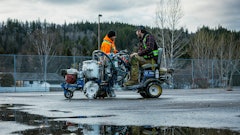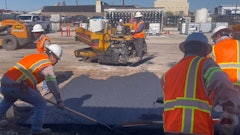Contractors involved in paving and pavement maintenance work in a broad construction economy that can differ by market segment and location. Here’s what several specialists expect for 2017 and beyond.
Building construction
Q. Did building construction in both the commercial market and single- and multifamily homes continue to gain momentum in 2016 as expected? What is your estimate of starts for 2017 for both the commercial and housing markets?
Ken Simonson, Chief Economist, Associated General Contractors of America (AGC). Office construction, which started to take off in 2015, grew even faster in 2016. Based on the huge projects that have been announced for numerous cities, 2017 will be another strong year for office work. Most of that is happening in center cities and entail mixed-use projects, unlike the stand-alone, low-rise, suburban office parks that predominated before the recession.
Data centers, warehouses and hotels have been hot segments for several years. That continued in 2016. For 2017, the data center niche appears to remain strong, although, ironically, there is no data on data centers as a separate category. Warehouse work is likely to post slower growth, and hotel work could turn negative in 2017 or early in 2018. Retail construction, aside from the ground floor of mixed-use buildings, is headed for another weak year.
Among institutional categories, school construction is benefiting from passage of more school-district bond issues. But growth is likely to be modest. Meanwhile, state university and community college construction is being hurt by declines in enrollments and in state revenues in many places. Healthcare construction will probably grow, but not dramatically.
Multifamily construction put in place again grew faster than single-family in 2016. But starts for multifamily have declined recently. There is no longer an overhang of permits and apartment rents have ticked down in some previously fast-rising metro areas. These indicators all point to a downturn in multifamily construction spending once current projects finish up. That could occur in late 2017 and is very likely by 2018. Single-family spending growth has been inconsistent but should accelerate slightly in 2017.
Robert Dietz, Chief Economist, National Association of Home Builders (NAHB). NAHB expected to see gathering strength for single-family construction, and a slowing of growth for multifamily development in 2016. For the most part, this has proved true.
Multifamily development has slowed as that market seeks a balance between supply and demand. Multifamily starts for 2015 likely represented a cycle high. We expect multifamily starts for 2017 to be just over 380,000.
Single-family construction continues to recover. We expect single-family starts to be up 8% for 2016, and more gains in 2017 and 2018 as additional labor and lots are added to the industry’s production pipeline. NAHB is forecasting single-family starts to total a little more than 870,000 in 2017.
Dr. Alison Premo Black, Vice President and Chief Economist, American Road & Transportation Builders Association (ARTBA). The ARTBA forecast also looks at private highway, bridge, parking lot and driveway work that is part of residential and commercial construction. Based on historical data, ARTBA estimates the private market will increase in 2017, and will continue to grow over the next five years as overall construction activity increases in those sectors.
HIS Markit. In 2016, the residential market has been largely been driven by spending on construction of multifamily units, as single family construction took a step back. Drivers of growth in the multifamily market continue to be related to pent-up demand from the recession, as well as a new generation of households that seems to be wary of actual home buying and content to rent. Single-family construction faltered as labor and financing constraints held back activity. Looking ahead, construction spending in 2017 will moderate in the multifamily segment as supply begins to align with demand. Single-family construction is expected to remain weak as pent-up demand is releasing slowly into the market. Housing starts are expected to grow at a stronger pace in 2017 than in 2016.
In the commercial segment, growth has been relatively strong in 2016. Growth for 2016 will be stronger than that seen in 2015 as both the office and lodging components have remained robust through the first nine months of the year. The outlook for 2017 calls for spending on commercial construction to continue but at a more moderate pace. There is some impact to business from the strong dollar and moderate global growth expectations. In 2017, the strongest growth is expected in the office segment, which is being driven by employment, income, and consumer confidence gains that benefit from improving economic conditions. Warehouse construction will also be healthy in 2017 as the increasing share of e-commerce retail sales creates a greater need for distribution centers. (Source: Jeannine Cataldi, IHS)
Highway construction
Q: How did the passage of the FAST Act impact highway and bridge construction in 2016 and do you see a continuation of this spending level for 2017?
AGC. The FAST Act provided a little more federal money to states, as well as flexibility in using it. But continuing improvements in fuel economy and a slump in heavy truck sales and mileage mean there has been little or no growth in federal and state highway tax receipts. Highway construction spending in the first nine months of 2016 was actually slightly below the total for January through September 2015, and I don't expect much of a pickup in 2017. The best prospects for increases are in states that have raised their own gas taxes or other funding sources, or have approved toll projects, including public/private partnerships.
There should be an increase in large airport projects over the next several years. But other types of public infrastructure are lagging. Neither federal nor state budgets for construction are growing overall.
ABC. With $305 billion in federal funding authorized over five years, the financial uncertainty that surrounded a growing number of projects in various stages of development was mitigated, empowering individual state transportation leaders to move forward with projects that had been temporarily mothballed. Theoretically, this should have produced the unleashing of a significant volume of state and local government infrastructure spending.
For example, in June 2016, the Illinois Department of Transportation announced a six-year infrastructure repair plan to renovate 501 bridges and more than 2,500 miles of roadway in the state. Illinois has also been among the nation’s slowest growing states. Project leaders intend to use $134 million annually in FAST Act funds to support these projects. That said, these monies represent a relative small fraction of the total project cost estimated at $11.2 billion. This perhaps represents the fundamental issue with the FAST Act. While its passage demonstrated a rare ability for Republicans and Democrats to work together to pass a key piece of legislation, it didn’t really raise the bar on federal investment in infrastructure. In fact, the rate of spending increases is roughly equivalent to inflation, implying that the FAST Act falls far short of meaningfully helping America address its large and growing infrastructure gaps.
ARTBA. Although the December 2015 passage of the FAST Act law provided stability for public highway investment, the increases in the program funding levels are modest, just above anticipated project costs and inflation.
Many state DOTs did not obligate their federal funds in time for many projects to get started during the 2016 construction season. Nearly half of the FAST Act funds for FY 2016 —46 percent—were obligated in the last quarter of the federal fiscal year, between July and September 2016. Twenty percent of the federal funds available to the states weren’t obligated until September 2016.
Increased investment from state and local governments will be the main driver of any real growth in 2017 and the next few years. As was the case in 2016, the market will vary significantly from state to state. With some programs growing and others facing challenges, overall activity at the national level will be fairly flat.
IHS. The passage of the FAST Act allowed for spending to increase on highways and bridges in 2016. We expect that spending growth will remain healthy for this segment in 2017. This will be the second year of funding under this authorization with projects moving from planning stages to in progress.
At the federal level, the implications of the election results for our U.S. construction spending forecast are positive, in that infrastructure improvements have broad bipartisan support. The magnitude of the impact is less clear at this time. We expect our forecasts will evolve over the next several quarters. Once the Trump administration is in place, its policy proposals are detailed more clearly, and the budgets are formulated, the economic drivers will be in place to more clearly view the impact on construction spending forecasts.
At the state level, influences on spending would be tax revenues, which have been coming in lower than expected in many states in 2016. This may have a dampening effect on spending in 2017. (Source: Jeannine Cataldi, IHS).
Employment
Q. Was there a labor shortage in the construction industry in 2016 and, if so, do you see this trend continuing in 2017? What can the industry do to help alleviate future labor challenges?
AGC. AGC of America surveys members each summer about workforce issues. Of the 1459 respondents to the 2016 survey, two-thirds said they were having trouble filling at least one craft position, and half were having trouble finding supervisors or project managers. These fractions were actually down a bit from 2015 but still indicate a major, ongoing challenge for many contractors. Bureau of Labor Statistics data show that construction industry employment is rising at about double the growth rate for the overall economy, but contractors are listing open positions for longer, spending more on training and overtime. These measures all suggest that companies are finding workers but not ones with the level of construction experience they would prefer. That story is likely to continue in 2017.
Contractors are trying many ways of coping with this. They are getting involved with high schools, community colleges and workforce development agencies to get out the word that the industry is hiring and has well-paying, long-term employment opportunities. They are turning somewhat more to labor-saving equipment, methods such as BIM, and tools such as drones, 3-D printers and robots. In some cases, prefabrication allows substitution of factory for field workers. But there's no one-size-fits-all solution.
NAHB. Lack of labor is the number one factor holding back residential construction in a period of tight inventory. Over the last year, according to estimates from the Bureau of Labor Statistics and NAHB analysis, the job openings rate (unfilled jobs) has averaged just under 2.5% - the highest rate since before the recession. The workforce is aging, and a declining US labor force participation rate means adding jobs to the sector will continue to be a challenge. These trends will continue in the years ahead.
The industry must work collectively to recruit the next generation of construction workers. This will require a team effort between local building association, worker training groups like the Home Builders Institute, national trade groups like NAHB, and businesses large and small. It will involve partnering with high schools, trade schools and community colleges to communicate the demand for workers and the potential for career growth.
ARTBA. Highway and bridge contractor employment, as well as the average number of hours worked each week on the jobsite, have increased since 2013 as the overall transportation construction market has improved. In the most recent ARTBA Quarterly Industry Conditions Survey, contractors did report shortages for both skilled and unskilled labor compared to last year. The overall labor supply and demand for workers in each region will depend largely on the amount of public and private work in the state.

























